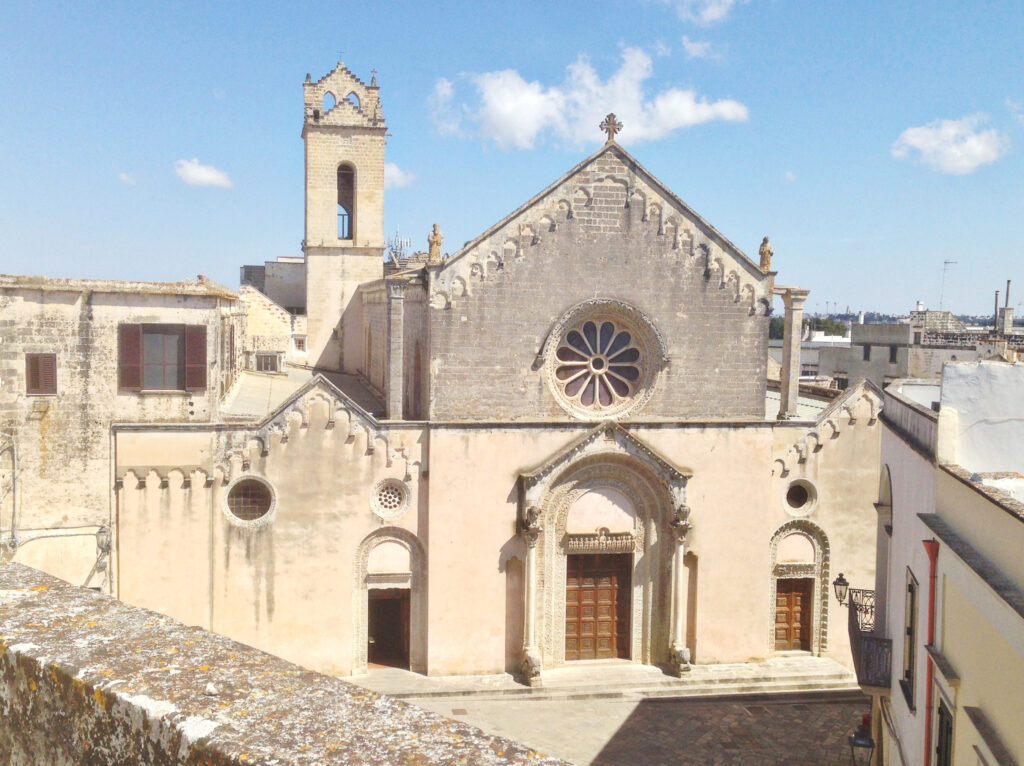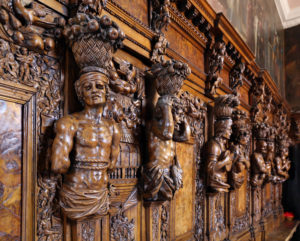Located halfway between Otranto and Gallipoli, Galatina is a city where people still practised ancient pagan rituals like tarantism after World War II. When I decided to visit it, out of curiosity, one of the many wonders I discovered in this little town in the Salento region was the splendid basilica of Santa Caterina d’Alessandria.
Romanesque in style, but with a mix of elements running from Gothic to Byzantine, this pink stone basilica is utterly unlike the classic Baroque churches of the capital and has an especially interesting history.

To start, it is the embodiment of a dream: the dream of a wealthy and powerful feudal lord, Raimondello Orsini del Balzo, who had it built between 1383 and 1385 and gave it to the Franciscan friars in 1391. The decision to dedicate the church to St Catherine, the cult of whom has eastern roots, was quite deliberate, since the Byzantine rite was widely followed in this remote region at the time. It is said that Raimondello, returning from a crusade, stopped at Mt Sinai to visit the monastery that preserved the saint’s body, stole one of her fingers and decided to build a church in her honour where the relic could be preserved.
In reality, the idea for the church emerged from the convergence of multiple interests. Given the unstable nature of his time, the wealthy feudal lord made his church into a reflection of a highly specific political plan. On the one hand, he wanted to launch a challenge to the capital of the kingdom, Naples, sending King Ladislas an image of his greatness and power and showing himself to be a king as well. On the other hand, he wished to make the basilica a stronghold of the Latin church and thus reinforce his crucial alliance with Urban VI.

The construction of the church was therefore a political act aimed to declare his feudal power, put him into contact with the papacy and serve as a bridge between east and west. Raimondello died in 1406, however, and it was his wife, Maria d’Enghien, who continued the work on the basilica, in agreement with the Franciscan friars, recruiting numerous Sienese artists and followers of Giotto to paint the frescoes that are the strong point of the whole endeavour.
Before entering, I stop to look at the facade. The three wooden portals are decorated with carved bands of pietra leccese. On the pediment, there is a cross with St Paul and St Francis on either side. The coats of arms of the patrons Angiò-Durazzo and D’Enghien-Brienne can be glimpsed in the middle of the magnificent central rose window with twelve radiating spokes. In the architrave of the main portal, there is a bas-relief of Christ and the Apostles, while a Greek inscription on the portal on the right, now illegible, stands as evidence that the Greek cult was surpassed by the Catholic faith of the patrons.

But it is walking into the church that takes one’s breath away. The interior of the basilica is majestic. The nave, wider than the two aisles, soars upward, culminating with a splendid cross vault. All around is a blaze of columns and capitals, vaults, walls and counterfacades entirely covered with frescoes. Since few were literate at the time, one needed to make use of images. We therefore find ourselves before a kind of visual primer, a “catechism”, that was used to teach the population. The frescoes, divided into nine cycles, were painted by a diverse team of artists, revealing different styles and different levels of quality, but most importantly new artistic forms in a geographic area that was still accustomed to Byzantine and eastern religious imagery. It would be difficult to describe the infinity of religious and secular symbols and meanings found in these cycles, each one of which was conceived with its own internal logic.
And it remains a mystery why the largest surface area was devoted to the Apocalypse; it is almost as if the patrons wished to give the whole project a sense of “regeneration”, a “rebirth” of the whole region under the dynasty of Raimondello Orsini del Balzo. And indeed, the principality of Taranto flourished under Maria d’Enghien and her son Giovanni Antonio, becoming the centre of a refined and sumptuous court.
What has stayed always with me is that the basilica of Santa Caterina d’Alessandria is the synthesis of a dream, or better, of a political ambition that promoted the Latinisation of customs and a peaceful regeneration between East and West. I recommend visiting it, immersing yourself in its timeless atmosphere, admiring its splendid frescoes and its lesson that civilisation is not strenuous defence of one’s values but rather extension of a bridge towards others.







